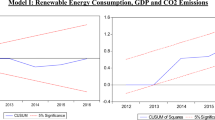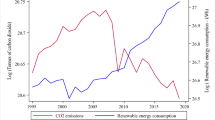Abstract
This paper aims to explore the impact of energy efficiency and renewable energy strategies adoption in CO2 emissions of 36 OECD countries during the period 2000–2019. The system GMM estimations demonstrate that energy efficiency and renewable energy decrease emissions. As for renewables technics effects, results suggest that hydropower and wind energy reduce emissions, but their impact magnitude is different. However, solar energy has not statistically significant impact on emissions. Furthermore, fossil fuels deteriorate environmental quality. A robustness check estimate has been conducted to test the validity of our results by changing the sample of studied countries and periods. When modifying the composition of the studied sample, the magnitude of impact differs considerably. However, by changing the studied period, results are affected as regards their significance.
Similar content being viewed by others
Notes
See countries list in Table 1 in the Appendix.
References
Aguir Bargaoui, S., Liouane, N., & Nouri, F. Z. (2013). Pollution and income growth: A Dynamic Panel Data Analysis. Global Journal on Advances Pure and Applied Sciences, 1.
Aguir Bargaoui, S., & Nouri, F. (2017). Dynamic Panel Data Analysis of CO2 Emissions Driving Forces. Journal of Economics Studies and Research.
Ahmed, A., Uddin, G., & Sohag, K. (2016). Biomass energy, technological progress and the environmental Kuznets curve: Evidence from selected European countries. Biomass and Bioenergy, 202–208.
Al-Mulali, U., Saboori, B., & Ozturk, I. (2015). Investigating the environmental Kuznets curve hypothesis in Vietnam. Energy Policy, 76, 123-131.
Apergis, N., & Payne, J. (2010). Renewable energy consumption and economic growth: Evidence from a panel of OECD countries. Energy Policy, 656–660.
Apergis, N., Payne, J. E., Menyah, K., & Wolde-Rufael, Y. (2010). On the causal dynamics between emissions, nuclear energy, renewable energy, and economic growth. Ecological Economics, 69, 2255–2260.
Arellano, M., & Bond, S. (1991). Some tests of specification for panel data: Monte Carlo evidence and an application to employment equations. The Review of Economic Studies, 58(2), 277-297.
Arellano, M., & Bover, O. (1995). Another look at the instrumental variable estimation of error-components models. Journal of Econometrics, 68(1), 29-51.
Balsalobre-Lorente, D., Shahbaz, M., Roubaud, D., & Farhani, S. (2018). How economic growth, renewable electricity and natural resources contribute to CO2 emissions?. Energy Policy, 113, 356-367.
Bargaoui, S. A., Liouane, N., & Nouri, F. Z. (2014). Environmental impact determinants: An empirical analysis based on the STIRPAT model. Procedia-Social and Behavioral Sciences, 109, 449-458.
Belaid, F., & Youssef, M. (2017). Environmental degradation, renewable and non-renewable electricity consumption, and economic growth: Assessing the evidence from Algeria. Energy Policy, 102, 277-287.
Bello, M. O., Solarin, S. A., & Yen, Y. Y. (2018). The impact of electricity consumption on CO2 emission, carbon footprint, water footprint and ecological footprint: The role of hydropower in an emerging economy. Journal of Environmental Management, 219, 218–230.
Ben Jebli, M., Ben Youssef, S., & Oztur, I. (2016). Testing environmental Kuznets curve hypothesis: The role of renewable and non-renewable energy consumption and trade in OECD countries. Ecological Indicators, 60, 824–831.
Bilgili, F., Koçak, E., & Bulut, Ü. (2016). The dynamic impact of renewable energy consumption on CO2 emissions: a revisited Environmental Kuznets Curve approach. Renewable and Sustainable Energy Reviews, 54, 838-845.
Biresselioglu, M. E., Kilinc, D., Onater-Isberk, E., & Yelkenci, T. (2016). Estimating the political, economic and environmental factors’ impact on the installed wind capacity development: A system GMM approach. Renewable Energy, 96, 636–644.
Blundell, R., & Bond, S. (1998). Initial conditions and moment restrictions in dynamic panel data models. Journal of Econometrics, 87(1), 115-143.
Blundell, R., & Bond, S. (2000). GMM estimation with persistent panel data: an application to production functions. Econometric Reviews, 19(3), 321-340.
Busu, M., & Nedelcu, A. C. (2021). Analyzing the Renewable Energy and CO2 Emission Levels Nexus at an EU Level: A Panel Data Regression Approach. Processes, 9, 130. https://doi.org/10.3390/pr9010130
Dietz, T., & Rosa, E. A. (1997). Effects of population and affluence on CO2 emissions. Proceedings of the National Academy of Sciences, 94(1), 175-179.
Dogan, E., & Ozturk, I. (2017). The influence of renewable and non-renewable energy consumption and real income on CO2 emissions in the USA: evidence from structural break tests. Environmental Science and Pollution Research, 24(11), 10846-10854.
Ehrlich, P. R., & Holdren, J. P. (1971). Impact of population growth. Science, 171(3977), 1212-1217.
Farhani, S., & Shahbaz, M. (2014). What role of renewable and non-renewable electricity consumption and output is needed to initially mitigate CO2 emissions in MENA region? Renewable and Sustainable Energy Reviews, 40, 80-90
Gomiero, T. (2015). Are biofuels an effective and viable energy strategy for industrialized societies? A reasoned overview of potentials and limits. Sustainability, 7, 8491–8521.
Halkos, G. E. (2003). Environmental Kuznets Curve for sulfur: evidence using GMM estimation and random coefficient panel data models. Environment and Development Economics, 8(4), 581-601.
Heryadi, M. D., & Hartono, D. (2016). Energy Efficiency, Utilization of Renewable Energies,and Carbon Dioxide Emission: Case Study of G20 Countries. International Energy Journal, 143–152.
Ito, K. (2017). CO2 emissions, renewable and non-renewable energy consumption, and economic growth: Evidence from panel data for developing countries. International Economics, 151, 1-6.
Jebli, M. B., & Youssef, S. B. (2017). The role of renewable energy and agriculture in reducing CO2 emissions: Evidence for North Africa countries. Ecological indicators, 74, 295-301.
Jebli, M. B., Youssef, S. B., & Ozturk, I. (2016). Testing environmental Kuznets curve hypothesis: The role of renewable and non-renewable energy consumption and trade in OECD countries. Ecological Indicators, 60, 824-831.
Kangyin, D., Xiucheng, D., & Cong, D. (2019). Determinants of the global and regional CO2 emissions: What causes what and where? Applied Economics. https://doi.org/10.1080/00036846.2019.1606410
Kaygusuz, K. (2007a). Energy for sustainable development: Key issues and challenges. Energy Sources, Part B: Economics, Planning, and Policy, 2, 73–83.
Kaygusuz, K. Y. (2007b). Renewable energy sources in the European union: Markets and capacity. Energy Sources, Part B: Economics, Planning, and Policy, 2, 19–29.
Lau, L. S., Yii, K. J., Lee, C. Y., Chong, Y. L., & Lee, E. H. (2018). Investigating the determinants of renewable energy consumption in Malaysia: an ARDL approach. International Journal of Business and Society, 19(3), 886-903.
Levine, R., Loayza, N., & Beck, T. (2000). “Financial intermediation and growth: causality and causes.” Journal of Monetary Economics, 46(1), 31-77.
Ma, C., & Stern, D. (2008). Biomass and China’s carbon emissions: A missing piece of carbon decomposition. Energy Policy, (36), 2517– 2526.
Majeed, M., & Tariq; Luni, Tania. (2019). Renewable energy, water, and environmental degradation: A global panel data approach, Pakistan Journal of Commerce and Social Sciences (PJCSS), ISSN 2309–8619, Johar Education Society, Pakistan (JESPK), Lahore, Vol. 13. Iss., 3, 749–778.
Mbarek, M. B., Saidi, K., & Feki, R. (2016). How effective are renewable energy in addition of economic growth and curbing CO2 emissions in the long run? A panel data analysis for four Mediterranean countries. Journal of the Knowledge Economy, 1–13. https://doi.org/10.1007/s13132-016-0365-9
Mert, M., & Bölük, G. (2016). Do foreign direct investment and renewable energy consumption affect the CO2 emissions? New evidence from a panel ARDL approach to Kyoto Annex countries. Environmental Science and Pollution Research, 1–13.
Morales-Lage, R., Bengochea-Morancho, A., & Martínez-Zarzoso, I. (2016). The determinants of CO2 emissions:evidence from European countries. Castellon (Spain),Working papers.
OECD/IEA. (2019). Update on recent progress in reform of inefficient fossil-fuel subsidies that encourage wasteful consumption. https://oecd.org/fossil-fuels/publication/OECDIEA-G20-Fossil-Fuel-Subsidies-Reform-Update-2019.pdf
Pachauri, R. K., Gomez-Echeverri, L., & Riahi, K. (2014). Synthesis report: summary for policy makers.
Paramati, S. R., Mo, D., & Gupta, R. (2017). The effects of stock market growth and renewable energy use on CO2 emissions: Evidence from G20 countries, Energy Economics, https://doi.org/10.1016/j.eneco.2017.06.025
Roodman, D. (2007). A short note on the theme of too many instruments. Center for Global Development Working Paper, 125.
Roodman, D. (2009). How to do xtabond2: An introduction to difference and system GMM in Stata. The Stata Journal, 9(1), 86–136.
Salim, R., Yao, Y., & Chen, G. S. (2017). Does human capital matter for energy consumption in China?. Energy Economics, 67, 49-59.
Shafiei, S., & Ruhul A., S. (2013). Non-renewable and renewable energy consumption and CO2 emissions in OECD countries: A comparative analysis. energy policy.
Shahbaz, M., Balsalobre, D., & Shahz, S. (2018). The Influencing Factors of CO2 Emissions and the Role of Biomass Energy Consumption:Statistical Experience from G-7 Countries. MPRA: Munich Personal RePEc Archive, https://mpra.ub.uni-muenchen.de/87456/
Shi A. (2001). Population Growth and Global Carbon Dioxide Emissions. Development Research Group, the World Bank.
Solarin, S. A., Al-Mulali, U., & Ozturk, I. (2017). Validating the environmental Kuznets curve hypothesis in India and China: The role of hydroelectricity consumption. Renewable and Sustainable Energy Reviews, 80, 1578-1587.
Sulaiman, J., Azman, A., & Saboori, B. (2013). The potential of renewable energy: using the environmental Kuznets curve model. American Journal of Environmental Sciences, 9(2), 103.
Tajudeen, I. A., Wossink, A., & Banerjee, P. (2018). How significant is energy efficiency to mitigate CO2 emissions? Evidence from OECD countries. Energy Economics, 72, 200–221.
Tugcu, C. T., Ozturk, I., & Aslan, A. (2012). Renewable and non-renewable energy consumption and economic growth relationship revisited: Evidence from G7 countries. Energy Economics, 34, 1942–1950.
Windmeijer, F. (2005). A finite sample correction for the variance of linear efficient two-step GMM estimators. Journal of Econometrics, 126(1), 25-51.
Xu, B., Zhong, R., & Qiao, H. (2020). The impact of biofuel consumption on CO2 emissions: A panel data analysis for seven selected G20 countries. Energy & Environment, 31(8), 1498–1514.
York, R., Rosa, E., & Dietz, T. (2003). Footprints on the earth: The environmental consequences of modernity. American Sociological Review, 68(2), 279–300.
Acknowledgements
I would like to thank the editor and anonymous reviewers for their supportive comments and suggestions.
Author information
Authors and Affiliations
Corresponding author
Additional information
Publisher's Note
Springer Nature remains neutral with regard to jurisdictional claims in published maps and institutional affiliations.
Appendix
Appendix
Rights and permissions
About this article
Cite this article
Aguir Bargaoui, S. The Impact of Energy Efficiency and Renewable Energies on Environmental Quality in OECD Countries. J Knowl Econ 13, 3424–3444 (2022). https://doi.org/10.1007/s13132-021-00864-0
Received:
Accepted:
Published:
Issue Date:
DOI: https://doi.org/10.1007/s13132-021-00864-0




